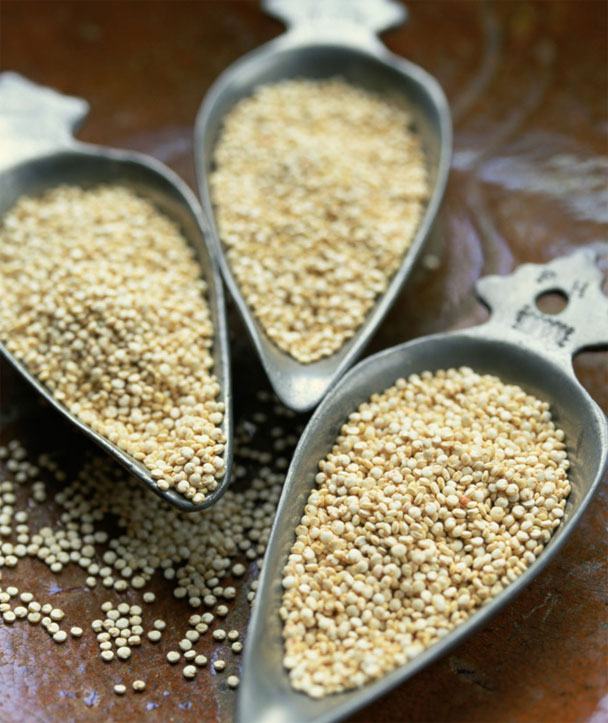
Whole Foods regularly runs out of it in their bulk bins. The New York Times referenced it online eight times in the past five months. It’s a top–ten search term on our sister site, Epicurious. And, finally, it’s hit the tipping point of proper pronunciation where enough people know enough about it to refer to it correctly. It’s the new food obsession that’s packing a powerful protein punch in a pinhead–size seed. Welcome to the spotlight, quinoa.
But what could possibly make this tiny cereal cause such a buzz? Quite simply, it’s a superfood, and according to a 1993 NASA Technical Paper, quinoa (pronounced KEEN–wa, in case you need a reminder), is unlike any other grain in that it is a complete protein with all eight essential amino acids in proportions that come close to or exceed those set by the Food and Agriculture Organization of the United Nations. What’s particularly outstanding about quinoa is its high level of the amino acid lysine, which most other grains lack. No other plant or animal beats it in overall nutritional qualities.
Although quinoa is often referred to as a grain—it’s cooked and eaten like one—it’s actually a pseudo–grain because it’s not a grass, but rather the seed of a broad–leaved plant related to spinach, Swiss chard, and lamb’s quarters (an edible weed). Whatever you want to call it, quinoa cooks up quickly in 20 minutes, making it ideal for time–strapped consumers looking to increase their consumption of whole grains. Compare that to brown rice or barley, both of which take twice as long! Quinoa is also easy to digest, and it’s gluten–free, which just might be the second biggest buzzword in today’s culinary scene.
But strip quinoa of all the good–for–you health claims, and judge it purely on taste. It’s light and fluffy with a slightly nutty flavor, and a delightfully chewy pop. And talk about versatile. Quinoa can go sweet or savory, whether it’s your breakfast porridge; the base of a dessert pudding, salad, or veggie burgers; or a thickener in stews. The list is truly endless.
Quinoa grows with an outer coating of its own natural insect repellent, saponin, that’s very bitter. Before the quinoa goes to market, the saponin is removed by washing or by mechanical abrasion. The repellent from the miniscule seed is sudsy and is often used in South America as a detergent for washing clothes and as a topical antiseptic. Whether the quinoa you buy has been washed or abraded to remove the saponin, it’s still a good idea to wash it again before cooking to make sure all of it is gone.
Quinoa comes in a range of colors that include far more varieties than what you see in stores in the United States. The most common ones here are beige, red, and black. I find the beige to be rather tame in flavor, almost to the point of being innocuous, so I prefer the red and the black. A mix of two or three hues gives a bowl of it a tweedy look.
But long before quinoa was on your table, and millennia before NASA began investigating it as a food for space travel, the tiny grains were actually a staple of the ancient Andean peoples. They’ve been cultivating and eating it since at least 3000 B.C. The Incas considered it their “mother grain” and held it in such high esteem that their leader supposedly planted the first seed each year with a gold shovel. Incan soldiers survived long treks with “war balls” made from quinoa and fat. And the Spanish conquistadores tried to destroy quinoa in their fight to take control of South America in the 1500s. They did a pretty good job of it, because quinoa lost its exalted role as a primary source of sustenance—except among small pockets of peasants—in the altiplano, or high–altitude plains, of Bolivia, Peru, Chile, and Argentina.
Since the rediscovery of this ancient grain in the 1970s, quinoa has grown into a big business in South America, particularly in Bolivia and Peru. Just how big is evidenced by the attempt by two Colorado State University professors to patent a traditional variety of quinoa, Apelawa. They were ultimately defeated thanks to outrage on the part of the Bolivian government and Bolivia’s National Association of Quinoa Producers, ANAPQUI.



 Pinterest
Pinterest


